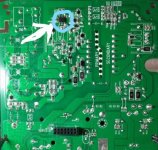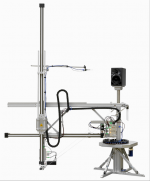Please try attaching pictures properly to the forum 
How to attach images to your posts.
Here is your picture.
How to attach images to your posts.
Here is your picture.
Attachments
I disagree there because external links are not permanent.
Think of how many threads have become useless because the externally hosted image/s are no longer there. Sometimes users delete them after only a matter of hours.
Just one of thousands:
Winfield's 100W DC-10MHz 1000V/us amplifier
Think of how many threads have become useless because the externally hosted image/s are no longer there. Sometimes users delete them after only a matter of hours.
Just one of thousands:
Winfield's 100W DC-10MHz 1000V/us amplifier
Please try attaching pictures properly to the forum
How to attach images to your posts.
Here is your picture.
Ok, thanks! I was in a hurry
I ended up buying the entire PCB =(.
I disagree there because external links are not permanent.
Think of how many threads have become useless because the externally hosted image/s are no longer there. Sometimes users delete them after only a matter of hours.
Just one of thousands:
Winfield's 100W DC-10MHz 1000V/us amplifier
A third way: put in the image attachment that gets shown in the thumbnail (not the link to the thumbnail itself -- when you are doing the attachment, it shows up as a link after being uploaded before you finally do the post -- copy and paste that link). Then put in a link that that attachment, which shouid stay since that link is to the DIYAudiio server.
Like this:
Last edited:
I had a very annoying "woody" resonance in my huge bass horns - I couldn't add braces inside the small back chamber so I bought a cheap (compared to some brands) box of adhesive bitumen sheets. They are I think 4mm thick but are soft enough to be cut with scissors; just peel the paper and apply them using something flat to put some pressure on the whole surface (I used a tool that looks like an iron) and you're good to go... I was a bit skeptical on wether I would hear a difference but I do! I think the brand is "sinus live" from Germany but I can check if anyone is interested.
...adhesive bitumen sheets. They are I think 4mm thick but are soft enough to be cut with scissors; just peel the paper and apply them using something flat to put some pressure on the whole surface (I used a tool that looks like an iron) and you're good to go....
Free measuring and testing services
Viscoelasticity - Wikipedia
[Spanish PDF] https://lotus.soprema.fr/www/reftechsop.nsf/($AllByUNID)/234C57F05BE834EDC12582AC00472B0B/$File/FT_INSSP002.b.ES_TECSOUND%20SY.pdf
Last edited:
A lot of graphs and explanations. With Klippel NFS speaker measurement system.

JBL 305P MKii and Control 1 Pro Monitors Review | Audio Science Review (ASR) Forum



At HF -> dominant H3
JBL 305P MKii and Control 1 Pro Monitors Review | Audio Science Review (ASR) Forum
At HF -> dominant H3
Attachments
Last edited:

Hi, I was opening up my JBL LSR 305 for the ferrite mod when I saw this on one of my LSR 305. One of the 1315A don't seem to be sealed properly it seems; it was the only 1315A of all 4 (2 per speaker) to have this pop up symptom
May I know what is it called and what should I replace it with?
It's an inductor (or coil) with a ferrite core. Most likely part of the low pass filter between the STA350BW class D amplifier chip out and the loudspeaker connector. If so, its value should be about 15 µH. Not any inductor will do, because core size, core material etc. are critical. You might be able to repair the existing one.
Last edited:
It's an inductor (or coil) with a ferrite core. Most likely part of the low pass filter between the STA350BW class D amplifier chip out and the loudspeaker connector. If so, its value should be about 15 µH. Not any inductor will do, because core size, core material etc. are critical. You might be able to repair the existing one.
Thank you, based on what you mentioned, the closest I saw so far is this:
Through Hole Shielded Inductors - RCS1315B SERIES - Manufacturer Coilmaster ELectronics but I am not confident if this is an exact replacement since I am not used to finding replacement inductors unlike capacitors. The usual electronics e-shops are not showing any inductor with the model name 1315A
I have also taken additional pictures of the mainboard for clarity; the parts numbers are L205 and L206
https://i.imgur.com/pgiDU9M.jpg
https://i.imgur.com/OorwjsY.jpg
Seeing all of these, I agree that I should try repairing the inductor (and do the capacitor mods too along the way). How should I repair the inductor and verify that the inductor is working normally via using a multimeter?
Last edited:
If it looks OK (most of the wire within or around the core material like it should be), the dc resistance is < 1 ohms, there is no obvious short circuit and the loudspeaker works, it probably is OK.
Thanks, let me try to get that out later and test it
Meanwhile, the ferrite mod mentioned here (and in GearSpace/Head-Fi) is surprisingly good. The tone feels slightly lower in volume (just a smidge lower though) and less bass amount (just a smidge lower too), but sound feels more resolved/accurate. While this is not different at a "day-and-night" level, this mod is much easier (since no soldering needed) and accessible (since you can just order the ferrites off Amazon) and even reversible (as long you do not throw away the original donut ferrite) compared to the others so this is worth a try
More importantly, by freeing up the cables instead of bunching them up together, it makes repairing/modding much more easier
Last edited:
You are making a wrong assumption.
AFAIK there is no digital processing inside, just the regular analogue trim switches.
Looking at the high resolution pictures darkarn uploaded a few posts back, I see an STM32 microcontroller, a Cirrus Logic 5341 ADC and an STA350BW switching amp that features a lot of DSP and only digital input.
So it definitely looks like there is digital processing going on.
Pretty amazing, at the price point of these speakers, even at the time they were announced.
Quick update: I have successfully repaired the inductor and will post the pictures later. Unfortunately I am unable to test this yet as my amp went down
Meanwhile, should I replace all capacitors including the power supply's too (especially that large 450V 100uf)?
My plan is to follow the various tweak guides here and replace the capacitors with much higher quality and lower ESR ones like Nichicon Gold series to cut down as much interference as I can; I think the LSR 305 is causing a large inrush current whenever I switch it on and that may be contributing to some strange behavior I am seeing in other equipment. I will doing one big order from my shops here so if can I'll like to order the needed capacitors too with that
Also, what's the exact name of those white substance around the components? Are they silicone and should I look into replacing/adding more of them?
Meanwhile, should I replace all capacitors including the power supply's too (especially that large 450V 100uf)?
My plan is to follow the various tweak guides here and replace the capacitors with much higher quality and lower ESR ones like Nichicon Gold series to cut down as much interference as I can; I think the LSR 305 is causing a large inrush current whenever I switch it on and that may be contributing to some strange behavior I am seeing in other equipment. I will doing one big order from my shops here so if can I'll like to order the needed capacitors too with that
Also, what's the exact name of those white substance around the components? Are they silicone and should I look into replacing/adding more of them?
Last edited:
Glad to hear that you have repaired the inductor.
I you do not like the speakers, the cheapest solution is selling them and buying better ones.
Interference has more to do with the pcb layout / circuit design, not with component quality.
There is no need to replace the capacitors.
The white substance is for physical strength, it protects the component leads from breaking. This is important during shipping and when the speakers are dropped. Sometimes yellow glue is used and sometimes yellow glue breaks down and becomes conductive, though that does not happen with the white stuff.
I you do not like the speakers, the cheapest solution is selling them and buying better ones.
Interference has more to do with the pcb layout / circuit design, not with component quality.
There is no need to replace the capacitors.
The white substance is for physical strength, it protects the component leads from breaking. This is important during shipping and when the speakers are dropped. Sometimes yellow glue is used and sometimes yellow glue breaks down and becomes conductive, though that does not happen with the white stuff.
Last edited:
Glad to hear that you have repaired the inductor.
I you do not like the speakers, the cheapest solution is selling them and buying better ones.
Interference has more to do with the pcb layout / circuit design, not with component quality.
There is no need to replace the capacitors.
The white substance is for physical strength, it protects the component leads from breaking. This is important during shipping and when the speakers are dropped. Sometimes yellow glue is used and sometimes yellow glue breaks down and becomes conductive, though that does not happen with the white stuff.
Thanks, I like the speakers, that's why I wanted to make them better like how these guides have shown since that is the much cheaper way to improve the sound of my set up compared with starting over with newer speakers, not to mention that if I want to upgrade speakers, the next in line will cost at least 3 to 5 times of these!
As for the white stuff, thanks, I understand a bit better now. Kinda glad that I have at least removed the dried yellow glue on the inductor at least
STA350 had limited DSP, but enough for 2 way filtering and some corrections.Looking at the high resolution pictures darkarn uploaded a few posts back, I see an STM32 microcontroller, a Cirrus Logic 5341 ADC and an STA350BW switching amp that features a lot of DSP and only digital input.
So it definitely looks like there is digital processing going on.
Pretty amazing, at the price point of these speakers, even at the time they were announced.
I had made digital input (SPDIF) 2-way active speakers with STA350. Relatively OK, only STA350 distortion and nose are little high. STA350, if I remember correctly, had no registers protection so reverse engineering is possible. After power up, when STM32 had written configuration to STA350, it must be possible to read all registers out over I2C if STM32 is disconnected.
- Home
- Loudspeakers
- Multi-Way
- JBL LSR305 tweaking


